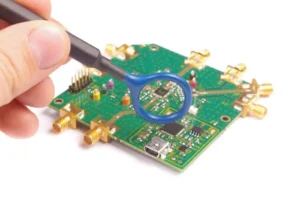The first thing involved in the EMC design consideration of a PCB is the layer setting; the number of layers of a single board consists of the number of layers for power and ground and the number of layers for signals; a good PCB design is a very important factor in the EMC design of a product, in addition to the component selection and circuit design.
The key to EMC design for PCBs is to minimize the return area and allow the return path to flow in the direction we designed. The layer design is the foundation of the PCB. How can we do a good PCB layer design to get the best EMC results for the PCB?
I. Design ideas for the PCB layer
The core of the PCB stack EMC planning and design thinking is to plan the signal return path rationally and minimize the signal return area from the single board mirror layer as much as possible, making the flux pair eliminated or minimized.
Single board mirror layer
The mirror image layer is a full copper plane layer (power supply layer, grounding layer) inside the PCB adjacent to the signal layer. It has the following main functions:
(1) Reduce return noise: The mirror layer can provide a low impedance path for signal layer return, especially when there is high current flow in the power distribution system.
(2) Reduced EMI: The presence of the mirror layer reduces the area of the closed loop formed by the signal and return current, reducing EMI;
(3) Crosstalk reduction: Helps control the crosstalk problem between signal alignments in high-speed digital circuits. By changing the height of the signal lines from the mirror layer, the crosstalk between signal lines can be controlled, and the smaller the height, the smaller the crosstalk;
(4) Impedance control to prevent signal reflection.
Mirror layer selection
(1) Power and ground planes can be used as reference planes and have a certain shielding effect on the internal alignment;
(2) The power plane has a relatively high characteristic impedance and a large potential difference from the reference level, while the high frequency interference on the power plane is relatively large;
(3) From the shielding point of view, the ground plane is generally grounded and used as a reference level reference point, and its shielding effect is much better than that of the power plane;
(4) When choosing a reference plane, the ground plane should be preferred and the power plane second.
II. Principle of magnetic flux pair elimination
According to Maxwell’s equations, discrete charged bodies or currents, all electrical and magnetic interactions between them are transmitted through the intervening region between them, whether the intervening region is a vacuum or solid matter. The magnetic flux in a PCB always propagates in the transmission line, and if the RF return path is parallel to its corresponding signal path, the flux on the return path is in the opposite direction to the flux on the signal path, at which point they superimpose on each other, and the effect of flux pair elimination is obtained.
III. The nature of flux pair elimination
The essence of flux-to-cancellation is the control of the signal return path, as shown in the following schematic:
Fourth, the right-hand rule explains the effect of magnetic flux on extinction
How to use the right-hand rule to explain the flux pair cancellation effect when the signal layer is adjacent to the ground layer, explained as follows:
(1) When a current flows in a wire, a magnetic field is generated around the wire, and the direction of the field is determined by the right-hand rule.
(2) When there are two wires close to each other and parallel, as shown below, with current flowing outward in one conductor and inward in the other, if the current flowing through the two wires is the signal current and its return current, respectively, then the two currents are equal in magnitude and opposite in direction, so their magnetic fields are also equal in magnitude and opposite in direction, and can therefore cancel each other out.
Specific principles of PCB layer design:
(1) Complete ground plane (shield) below component side, solder side;
(2) Avoid two signal layers directly adjacent to each other as much as possible;
(3) All signal layers are adjacent to the ground plane whenever possible;
(4) Critical signal wiring layers such as high frequency, high speed, and clock should have an adjacent ground plane.
















